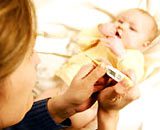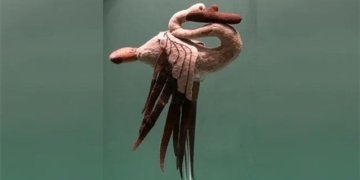Febrile seizures are a common medical condition in young children, especially during changes in weather and climate.
 |
(Photo: VNE) |
Seizures can create panic among caregivers and may pose risks to the child. If the seizure is not controlled, the child’s brain can experience oxygen deprivation, leading to cognitive impairment and the potential for epilepsy if seizures are prolonged or recurrent.
Why do children experience febrile seizures?
Children’s brains have approximately 14 billion neurons, similar to adults, but these neurons do not fully differentiate until around the age of 8. Chemically, children’s brains contain more water and protein and less lipid than adult brains.
Fever typically results from bacterial or viral infections. Due to the undifferentiated neurons and the high water content, a child’s brain is easily stimulated during high fevers, causing neurons to discharge suddenly and excessively, leading to generalized seizures.
How to recognize a febrile seizure?
- Commonly occurs in children aged 6 months to 5 years.
- Seizures occur at temperatures above 39°C and resolve when body temperature drops below 39°C.
- Typically presents as generalized seizures.
- Each seizure usually lasts no longer than 10 minutes.
- After a seizure, the child often sleeps. If awakened, the child should be alert and not in a stupor.
- Family history may include instances of febrile seizures.
What to do when a child has a febrile seizure?
- Keep the child lying still and minimize stimulation.
- During the seizure, place the child on their back with their head tilted slightly to one side. Remove excess clothing to help the child breathe and reduce body temperature. Use a soft object or washcloth between their teeth to prevent biting the tongue. Absolutely do not use hard objects to hold the child’s mouth open to avoid dental damage, and do not restrain the child to prevent bone fractures.
- Once the seizure stops, immediately place the child in a safe position (turning them onto their side with their head slightly tilted back) to prevent any vomit from entering the respiratory tract.
- Wipe the child down with a warm washcloth several times, particularly in the armpit and groin areas, to help reduce body temperature.
- Cool the surrounding environment by limiting the number of people around the child and opening windows and doors for ventilation.
- Consider administering a fever-reducing suppository at a dosage of 15-20 mg/kg of body weight.
- Take the child to the nearest medical facility for timely examination and treatment.
How to prevent febrile seizures in children?
- Take the child to a healthcare facility at the first sign of fever. Do not allow the child’s temperature to exceed 39°C.
- Ensure the child drinks plenty of fluids or breastfeeds more than usual.
- Keep the child in a cool environment, remove excess clothing, and do not wrap the child tightly.
- Use warm water to sponge the child’s body to cool them down.
Dr. TRAN VAN PHUC (Xanh Pon Hospital)




















































